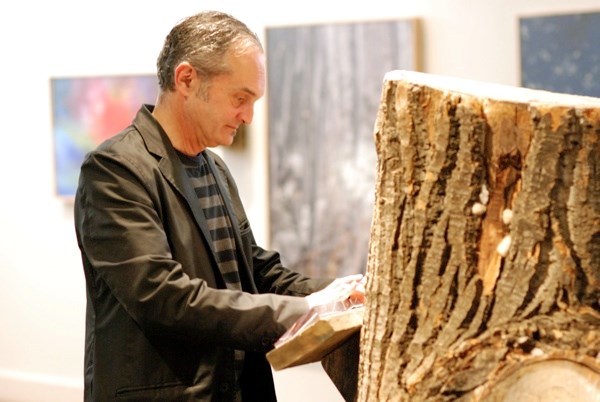Marcus Miller may be the new director of galleries for North Battleford, as well as the new curator for the Allen Sapp Gallery, but he already has a clear goal in mind: making Allen Sapp a recognized part of art history in Canada.
"Now it's time to get Allen Sapp into the textbooks, into the art history textbooks," said Miller. "I want other curators and historians to know about Allen Sapp. I want him to be on their minds when they're curating shows."
This last was said with a nod to Dean Bauche, the former curator and director of galleries, whom Miller said did a fantastic job of contextualizing the work of Allen Sapp, as well as promoting Sapp nationally.
"He did a whole lot of great things for Allen Sapp," said Miller.
And now Miller is taking what he sees as the next step, establishing Sapp as a historic icon in the world of art history.
Miller explained that prior to the work of aboriginal artists such as Allen Sapp and Norval Morrisseau, First Nations artists were not really considered as professionals in the art world, nor were they given the status of artists.
"It's not that they weren't making art or doing creative things," said Miller, "they were, but it was always presented to people as artefacts, as ethnographic artefacts."
Miller points to the curatorial work being done on the Professional Native Indian Artists Incorporation. The group, comprised of Daphne Odjig, Alex Janvier, Jackson Beardy, Eddy Cobiness, Norval Morrisseau, Carl Ray and Joseph Sanchez, is better known as the Indian Group of Seven, a name given them by a Winnipeg Free Press reporter in reference to the famous Canadian landscape painters known as the Group of Seven.
PNIAI, which came into being in the early 1970s, wanted to change the way their art was viewed, hoping to shift the focus from 'aboriginal' to 'artistic' value.
Unfortunately, the group disbanded after less than two years, but the importance of their contribution to the art scene in Canada is just starting to be recognized.
Miller said he would like to see Allen Sapp recognized alongside the Indian Group of Seven, because "he was right there establishing precedence with those artists."
Having a Bachelor degree in Fine Arts, as well as a Masters in the social history of art, Miller is particularly interested in how the past has influenced and continues to influence current artists, as well as how modern artists are taking art and making it their own.
One of Miller's favourite exhibits is The New Flâneurs, which he curated while at the Art Gallery of Alberta in Edmonton.
Miller said a curator's job is to find meaning in art and put pieces together in order to draw out that meaning.
"You're a storyteller," said Miller. "It's like you're writing a book in the gallery, so the paintings, the sculptures, the installations have to make sense with each other. You're telling a story and you're giving it a thematic coherence."
The exhibit, which mixed contemporary art with historical art, derived its name from flâneur, a term coined by writer Charles Beaudelaire for people who walk the city, not to get from point A to B, but in order to experience it. Beaudelaire said a flâneur was "a botanist of the sidewalk."
"The New Flâneurs mixed all of this historical and contemporary art together and the feed for it, in my mind, was looking at these kids out on the street doing this new thing called parkour," said Miller.
Parkour was developed in France by the son of a military officer, and involves looking at the city as a series of obstacles in the event a person was escaping from another person. The idea has since evolved, and now doesn't necessarily involve the shortest route, but the most dramatic and acrobatic.
A famous instance of parkour is in the opening scene of Casino Royale, points out Miller.
"What I did in [The New Flâneurs] was I looked for instances of people using the city and refiguring it in their heads for themselves and this was a historical thread I could draw throughout history," said Miller.
He pointed to the example of ruins, which weren't always seen as being beautiful or romantic, but as being exactly what they were: ruins.
Miller ties this back to what Allen Sapp did when he made the art world and the definition of artist his own. As director of galleries, Miller said he's also excited to see what younger First Nations artists, whom he believes are standing on the shoulders of artists like Sapp and Morrisseau, will do to make their art their own.
"Now is the time for contemporary aboriginal artists," said Miller. "They are blossoming, they are going to art school, they're really interested in their roots and they're figuring out how to put it all together and mix it up and they're creating something new," said Miller.
He said he'd like to see the Allen Sapp Gallery and the Chapel Gallery come closer together.
Miller moved to North Battleford from Lethbridge, although he's lived in a number of places, including Edmonton, Montreal, Toronto and Vancouver.
He just celebrated his 31st anniversary with his wife, Mindy Ann, who he calls his childhood sweetheart, as the two met when they were in Grade 7. The couple attended art school together in Halifax, and have a 10-year-old son.




